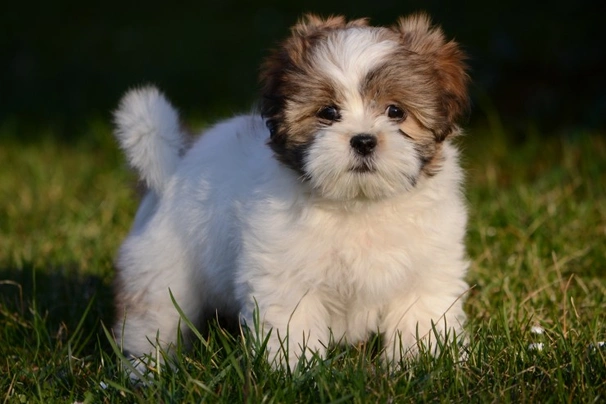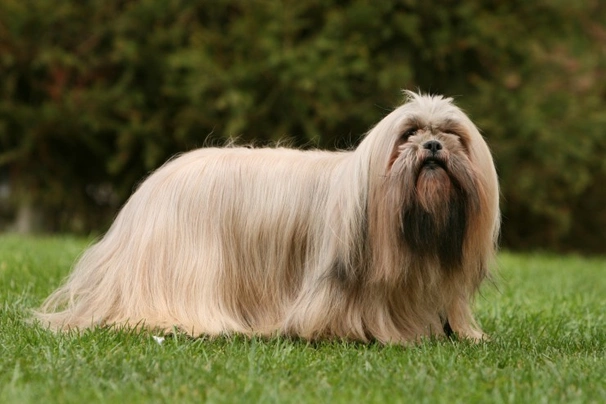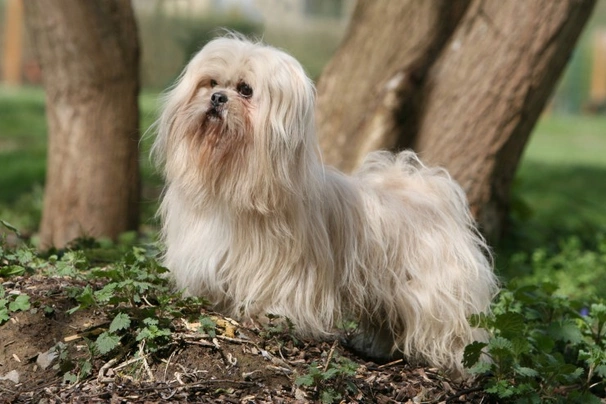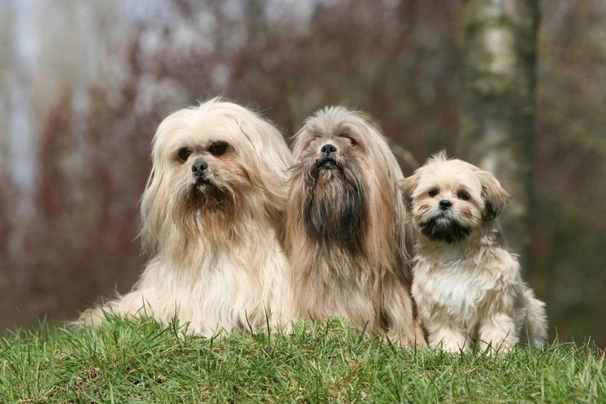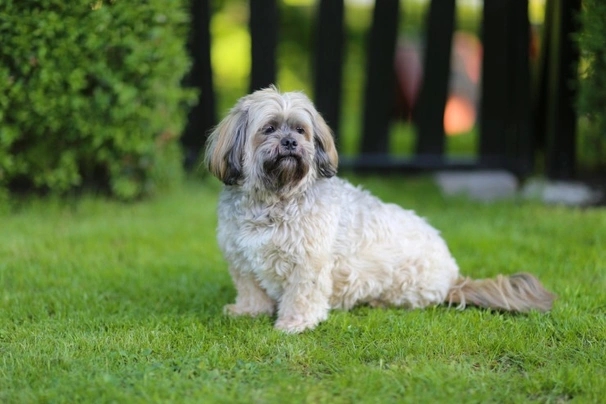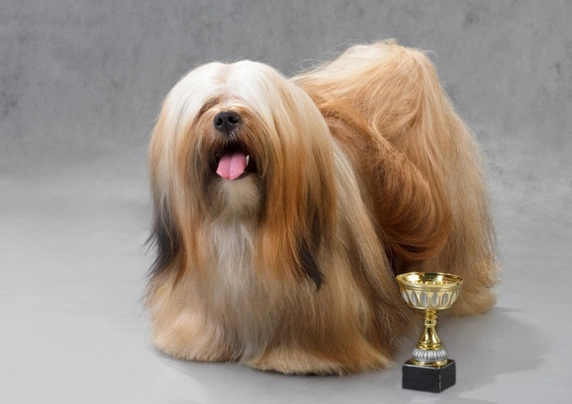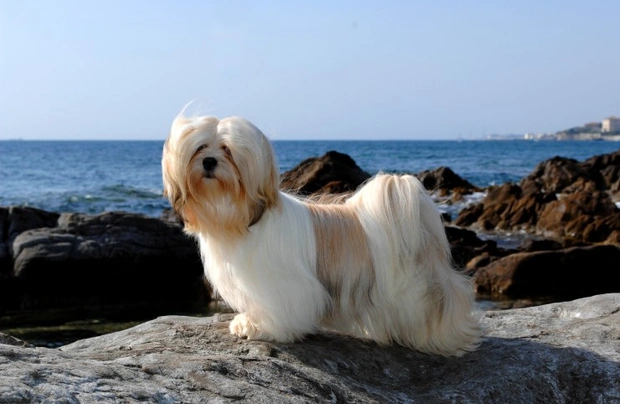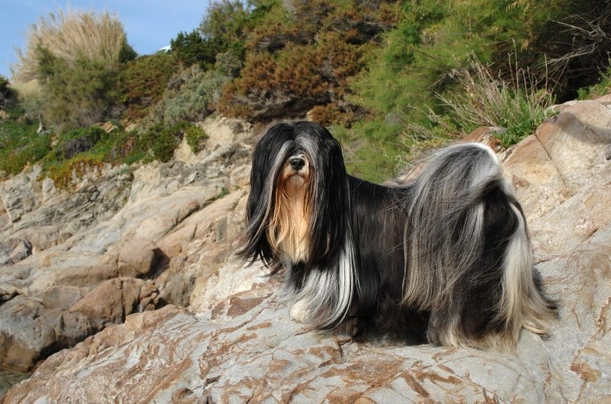Lhasa Apso
Pros
Cons
Introduction of the Lhasa Apso
The first time the Lhasa Apso appeared in the UK was in the twenties when these little Tibetan dogs were an immediate hit. Lhasas boast a fascinating history having been the dogs of choice with both Tibetan holy men and nobles alike. Today the Lhasa Apso is still a firm favourite with people not only here in the UK but elsewhere in the world and for good reason. The Lhasa breed has consistently ranked as being among the most popular little dogs in the country.
Lhasa Apsos are charming affectionate fun-loving dogs that boast having adorable looks and the fact they make great family pets and companion dogs means they are incredibly versatile too with the added bonus being they are known to be tolerant around children and other dogs providing they have been well socialised from a young age. In short the Lhasa Apso is an all-round lovely little dog to be around and share a home with.
History of the Lhasa Apso
The Lhasa Apso was originally bred in the mountains of Tibet where they were highly revered by holy men and nobles. There are records of these charming little dogs having been kept both as pets by the monks and to guard monasteries and temples. It is thought the breed has been around for at least 2000 years and that Lhasas were thought to be reincarnations of the Holy Lamas after they passed away. A Lhasa Apso was very rarely sold during this period of history they were however offered as gifts to deserving and privileged people. Those who were fortunate enough to be given one of these charming dogs knew they had been deeply honoured because a Lhasa Apso was always revered for being "a bringer of good fortune" to whoever who owned one.
Although it is thought the breed were introduced to the UK way back as far as 1854 to begin with there is some confusion as to whether the first dogs were in fact Lhasa Apsos or Tibetan Terriers but by the beginning of the 20th century both dogs were categorised as being one breed which was known as either the Lhassa Terrier the Thibetan Bhuteer or Bhutan. With this said the differences between the two dogs were quite evident even back then more especially when it came to their size and coat types.
Sir Lionel Jacob was the first to "describe" the Lhasa Apso in 1901 and called the breed the Lhassa Terrier. A few years later in 1908 the breed was awarded Championship status although at the time they were exhibited in classes according to a dog's size.
The Tibetan Breeds Association was founded in 1934 and their goal was to finally separate and make a clear distinction between the various breeds that boasted Tibetan origins. A breed standard for the Lhasa Apso was established the same year. At the time few Lhasa Apsos were around with a mere 12 dogs being exhibited at Crufts and the Ladies Kennel Association in the mid-thirties. Only 10 Lhasas were registered with the Kennel Club at the time too.
At the end of the Second World War breed numbers fell and it took a little while before their numbers started to rise again. Breed enthusiasts began importing more dogs from Tibet as it was still possible to do so at the time because China had not imposed any sort of ban. A little later more Lhasas were bought over from the States and India. By the mid-fifties breed numbers had risen significantly so that owners outside of Tibet decided it was time to leave the Tibetan Breeds Association. In 1956 the Kennel Club approved the foundation of the Lhasa Apso Club in the UK and the breed was renamed the Tibetan Apso in 1959 with championship status being awarded six years later in 1965.
In 1970 the breed's name was changed again back to the "Lhasa Apso" when the formal Lhasa Apso Club we know today was founded. The breed standard was reviewed in 1973 only to be revisited again a few years later which established the standard that still exists today. A dog called Ch Saxonsprings Hackensack was the first Lhasa to be awarded Best in Show at Crufts in 1984 and Ch Zentar Elizabeth won the title in 2012. Today these little dogs are still as popular with owners all over the world thanks to their great looks and kind natures. However Lhasa Apsos are considered a rare breed in their native Tibet even to this day.
Interesting facts about the breed
- Is the Lhasa Apso a vulnerable breed? No they are among the most popular dogs in the UK and elsewhere in the world thanks to their adorable looks and kind loving natures.
- Lhasas are one of the more ancient breeds in the world
- Their name means Bark Lion Sentinel Dog in Tibetan
- They were once thought to be the reincarnation of Tibetan monks who had passed away
- In ancient times Lhasas were rarely sold but they were often to the privileged few as honoured gifts that would bring them good fortune
- Lhasas enjoy long life spans with the oldest Apso on record having lived to the ripe old age of 29 years
- They are extremely popular with celebrities
- Lhasas are known to suffer from “reverse sneezing” which is often referred to as the “Lhasa Snort” and the “Lhasa Puff”
Appearance of the Lhasa Apso
Height at the withers: Males 25 - 28 cm Females 23 - 25 cm
Average weight: Males 6 - 7 kg Females 5 - 6 kg
The Lhasa Apso is a nicely proportioned sturdy little dog that boasts a heavy and plush coat. They have a lot of hair that falls over their eyes but it does not interfere with a dog's vision. They also have nice beards and full whiskers which adds to their overall charming appeal. Their heads are quite narrow with a dog's skull falling away behind their eyes. Stops are medium and dogs boast black noses at the end of a short muzzle.
Eyes are oval and medium in size being dark in colour and well placed at the front of a dog's face. Their ears are nicely feathered and pendant falling neatly. They have a reverse scissor bite and strong jaws. Necks are strong and nicely arched falling to a dog's well laid-back shoulders. Their front legs are straight and heavily feathered.
The Lhasa Apso is a compact looking dog with ribs that extend well down their body and a nice level topline. Loins are strong adding balance to their overall appearance. Hindquarters are well muscled and well developed with a nice angulation with back legs being heavily furnished. Their feet are very cat-like being rounded with firm paw pads and well feathered. Tails are well feathered and set high which dogs carry over their backs and they often have a kink at the end.
Top coat long heavy straight hard neither woolly nor silky. Moderate undercoat. Coat never impeding action.
When it comes to their coat the Lhasa Apso boasts a heavy straight and long top coat that’s neither silky or woolly to the touch. They have a moderate softer undercoat. The accepted breed colours that can be registered with the Kennel Club are as follows:
- Black
- Black & Tan
- Black & White
- Brindle
- Brindle & White
- Brown
- Brown & White
- Cream
- Cream & White
- Gold
- Gold & Black
- Gold & White
- Gold Brindle
- Golden
- Grey
- Grey & White
- Honey
- Honey & White
- Particolour
- Red
- Red & Gold
- Red & White
- Sandy
- Tan & White
- Tricolour
- White
Gait/movement
When Lhasas move they do so with a gay and jaunty action being free moving and covering a lot of ground.
Faults
The Kennel Club frowns on any exaggerations or departures from the Lhasa breed standard as it is set out and any faults would be judged on how much they affect a dog's health and welfare as well as their ability to perform.
Male Lhasa Apsos should have both testicles fully descended into their scrotums.
It is worth noting that a Lhasa Apso can be a little bigger or smaller and slightly heavier or a bit lighter than stated in their breed standard which is to be used as a guide only.
Temperament of the Lhasa Apso
The Lhasa Apso is an extremely affectionate and loving little dog and one that forms a strong bond with their owners and families. However they are known to have a bit of a stubborn streak and to be independent by nature which means they are not the best choice for first time dog owners simply because they can be a little harder to train. They also boast a lot of stamina and although not high energy dogs they like nothing more than to be taken for nice long and interesting walks. In short although great companions the Lhasa is not to be thought of as merely a lapdog like many other breeds of a similar size.
Their training and education must start early and puppies need to be well socialised from a young age for them to grow up to be more confident outgoing obedient dogs. Lhasas are sensitive characters and don’t like it when things get too loud around the home which often sees a dog becoming withdrawn and shy. As such they are not a particularly good choice of pet for families with toddlers and very young children.
Spoiling a Lhasa Apso although very easily done thanks to their cute looks would be a very big mistake because it could lead to dogs developing some unwanted behavioural issues which can often prove hard to correct further down the line when a dog is mature. They can often develop a condition known as "small dog syndrome" when they are not correctly handled and trained when young. They tend to be a bit aloof around strangers but would rarely show any sort of aggressive behaviour towards anyone they don't know preferring to keep their distance so they can survey a person from afar and let their owners know about their feelings.
Lhasas hate being left on their own for any length of time and if they are they suffer from separation anxiety simply because they crave the company of their owners so much. As such they are much better suited to households where one person stays at home when everyone else it out. With this said they tend to form the strongest bond with one person in a household which is typically the person who feeds and takes the most care of them.
Are they a good choice for first time owners?
Lhasas are not the best choice for first time dog owners because they can be quite wilful and headstrong when the mood takes them which makes them harder to train than many other breeds of the same size. They are also quite independent by nature and although they form very strong ties with their owners they like to "do" their own thing. In short Lhasas are devoted to their families without being too clingy.
What about prey drive?
The Lhasa Apso is known to have a low prey drive and will happily live with other animals and pets providing the introductions are made with care. However a Lhasa never likes it when a strange animal comes onto their territory and would be quick to chase them off which includes the neighbour's cat and any other animal they come across.
What about playfulness?
Lhasa Apsos love to entertain and being so smart they quickly learn how to please their owners which makes them all the more endearing to have around. It is however important to recognise when a Lhasa is playing and when they are showing a more dominant side to their natures which a dog would do if they are not given the right sort of training from the word go and not taught the boundaries and limitations from the get go.
What about adaptability?
Lhasas are highly adaptable little dogs and are just as happy living in an apartment in town as they would be in a house in the country providing they are given enough mental stimulation and daily exercise to prevent boredom from setting in.
What about excessive barking?
Unfortunately Lhasas are known to like the sound of their voices a little too much which can lead to excessive barking for no real reason. This is a trait that needs gently curbing when a Lhasa is still young and even then some dogs just can't help themselves when it comes to barking incessantly because it is something they were bred to do and as such a trait that is deeply embedded in their psyche. Lhasa were highly prized for being great watchdogs because they were quick to alert Tibetan monks of danger when they guarded the monasteries and temples.
With this said whenever a Lhasa is unhappy about something which includes being left on their own for any length of time they will bark which is their way of showing how unhappy they are at the situation and to get attention.
Do Lhasas like water?
Most Lhasas are not especially fond of water although some do like swimming and will happily jump in whenever they can. Anyone who shares a home with a Lhasa that does not like water should never force their pet to take a swim. Anyone who owns a Lhasa that likes swimming should take great care when walking their dogs off their leads anywhere near more dangerous watercourses just in case they leap in.
Are Lhasas good watchdogs?
Lhasas are social albeit protective dogs by nature and because they are wary of strangers and were bred to guard temples and monasteries in their native Tibet the instinct to guard and watch over property is something that's deeply embedded in a Lhasa's psyche and as such they make wonderful watch dogs.
Intelligence / Trainability of the Lhasa Apso
The Lhasa Apso is known to be an intelligent little dog but one that boasts a bit of an obstinate stubborn streak which can make it harder to train them. It's essential for puppies to be well socialised from a young age and this involves introducing them to as many new situations people and other dogs as well as animals as soon as they are fully vaccinated. As previously touched upon Lhasas are known to be independent little dogs by nature and are never happier than when they can "do" their own thing which often sees a dog turn a "deaf ear" to a command when the mood takes them.
If not well handled a Lhasa would quickly show a more dominant side to their natures which adds to the challenge of training them and why they are not best suited to first time dog owners. Lhasas need to know who is the "boss" and who they can look to for direction and guidance to be truly well-rounded obedient dogs.
The other thing to bear in mind is that Lhasas can be a little harder to house train which takes a little more time and patience. The good news is that a dog can be taught where to do their “business” it just takes understanding perseverance and gentleness. Because they are known to be quite sensitive by nature any harsh handling or raised voices would not achieve the best results with these little dogs.
The first command a Lhasa puppy should be taught when they arrive in a new home are as follows:
- Come
- Sit
- Stay
- Quiet
- Leave it
- Down
- Bed
Children and other
Lhasa Apsos are known to be trustworthy intelligent dogs and they do like being around children but they do not accept being handled roughly or pushed around which can see a dog retreating and even retaliating when they feel threatened. If pursued a Lhasa would go on the defensive which is why they are not the best choice for households with toddlers or very young children. To be safe any interaction between the kids and dogs should be well supervised by an adult to make sure playtime never gets too boisterous or rough which could end up with a child or dog being hurt.
Providing they are well socialised from a young age Lhasa Apsos do get on well with other dogs but it is worth noting that Lhasas can show a more dominant side to their natures when they are around dogs they have never met before. Care should be taken when they are anywhere near smaller animals and pets which includes cats unless they have grown up together. Lhasas are known to have a low prey drive and generally co-exist well with other animals and pets pretty well providing the introductions are done carefully.
Health of the Lhasa Apso
The average life expectancy of a Lhasa Apso is between 13 and 14 years when properly cared for and fed an appropriate good quality diet to suit their ages.
Like so many other breeds the Lhasa Apso is known to suffer from a few hereditary health issues which are worth knowing about if you are planning share your home with one of these active and good looking little dogs. The conditions that seem to affect the breed the most includes the following:
- Hip dysplasia
- Kidney failure
- Progressive Retinal Atrophy (PRA) - annual test available
- Reverse sneezing
- Patent Ductus Arteriosus (PDA) - a heart defect
- Hydrocephalus
More about Progressive Retinal Atrophy (PRA)
A Lhasa Apso can inherit Progressive Retinal Atrophy (PRA) and when tested only a dog with the condition would test "positive" having inherited the defective gene from both their parent dogs. The problem is when a Lhasa is tested and they come back "unaffected" which does not necessarily mean they don't have the defective gene and they can still be carriers having inherited the gene from just one of their parent dogs.
Anyone who is thinking about breeding from a Lhasa Apso must have their females tested annually to prevent her from passing on the defective gene on to her offspring. Test results should be sent to local Lhasa Apso Clubs so that records of any carriers can be kept for future reference.
More about reverse sneezing
Breeds with shorter noses typically have elongated palates and whenever they get excited about something they do something known as "reverse sneezing". This is a condition that does affect the Lhasa Apso. It happens because air or sometimes debris gets trapped under a dog's palate which causes irritation and can even impact their breathing. Although not a life-threatening condition it can be quite scary to witness and often a dog can be frightened when they experience an episode of reverse sneezing which means offering them a lot of reassurance when it does. The best way to deal with a Lhasa when they start reverse sneezing is to gently place the palm of a hand over their noses which forces a dog to breath more deeply through their mouths but this must be done carefully so as not to frighten a dog even more.
More about Patent Ductus Arteriosus (PDA)
When puppies and all other living beings are first born they must adapt to living in an oxygen environment after having existed in a fluid one for several months. The ductus arteriosus is one of the more important blood vessels that allows for this process to take place properly. The blood vessel is found next to a dog's heart and it connects the vital pulmonary artery to the aorta. When puppies are born blood flowing through the ductus arteriosus is no longer needed because they start to breath on their own once an umbilical cord is cut. This is when the ductus arteriosus starts to shrink until it's completely closed off because it is no longer needed.
Should the ductus arteriosus not close off as it should within 48 hours blood recirculates through the heart which increases its workload considerably putting the organ under a lot of extra pressure. This can end up with a dog suffering complete heart failure and why it's so important for the problem to be resolved surgically as soon as possible once the condition has been successfully diagnosed.
It is thought the problem could be a genetic sex-linked condition with some dogs being more predisposed to inheriting it than others. As such female Lhasas are much more likely to suffer from the disorder than their male counterparts. Because a dog's heart works that much harder they typically show serious signs of being ill when they are anything from 1 to 2 years old and because the strain on the heart continues a dog would never get any better without surgical intervention. Another problem being that even when a dog does undergo surgery if left too late the damage to the heart is so great it is permanent.
Any Lhasa Apso diagnosed with the condition should never be used for breeding purposes and any of their siblings should be screened before being used in a breeding programme.
More about Hydrocephalus
Hydrocpehalus is seen in young Lhasas when they under 18-months old although dogs over 6 years old can also suffer from the condition. The disorder affects a dog's brain where cerebrospinal fluid does not drain as it should which results in a build-up of fluid in the two connecting chambers of the brain.
The condition can be congenital or acquired and if left untreated the prognosis is very poor with most dogs dying as a result. With the Lhasa Apso and toy breeds being the most predisposed to suffering from the condition it is important for potential owners to obtain a full medical history of parent dogs before buying a puppy.
What about vaccinations?
Lhasa puppies would have had their first vaccinations but it's essential for them to have their follow-up jabs at the right time with the vaccination schedule being as follows:
- 10 -12 weeks old bearing in mind that a puppy would not have full protection straight away but would be fully protected 2 weeks after they have had their second vaccination
There has been a lot of discussion about the need for dogs to have boosters. As such it's best to talk to a vet before making a final decision on whether a Lhasa Apso should continue to have annual vaccinations which are known as boosters.
What about spaying and neutering?
A male Lhasa Apso can safely be neutered when they are 6 months old and females can be spayed when they are 6 months old too.
What about obesity problems?
Lhasas like to be kept busy and as previously mentioned they are not lapdogs in any sense of the word but it's important to keep an eye on a dog's weight and to adjust the amount of daily exercise they are given and rethink their diet making sure a dog is not being given too many "food" treats in between meals. It is also worth noting that some Lhasas will put on weight after they have been spayed or neutered and again it's important to adjust a dog's calorie intake accordingly if they do.
What about allergies?
Some Lhasas suffer from allergies which can be triggered by several things which includes certain foods. The problem is often identifying just what causes an allergy to flare up in the first place. It's a good idea to keep a diary of when an allergy flares up and to note down what a dog eats the time of year and whether any new household products have been introduced to the home. The various triggers that can cause an allergenic reaction in dogs include the following:
- Environment
- A reaction to certain chemicals commonly found in household cleaning products
- Seasonal allergies which includes pollen and grasses
- Food which includes certain meats and cereals often used as ingredients in commercially produced dog food
- Tick and flea bites
- Dust mites
- Mould
Participating in health schemes
All breeders should have stud dogs tested for PRA using the following scheme:
- Eye testing for Progressive Retinal Atrophy (PRA)
What about breed specific breeding restrictions?
Currently there are not breed specific restrictions for the Lhasa Apso.
What about Assured Breeder requirements?
It is mandatory for all Kennel Club Assured Breeders to have their stud dog tested for PRA (progressive retinal atrophy) before using them in a breeding programme using the available test:
Caring for the Lhasa Apso
As with any other breed the Lhasa Apso needs to be groomed on a regular basis to make sure their coats and skin are kept in top condition bearing in mind that they are high maintenance on the grooming front. They also need to be given regular daily exercise to ensure they remain fit and healthy which must include giving a dog enough mental stimulation to prevent boredom from setting in. On top of this dogs need to be fed good quality food that meets all their nutritional needs throughout their lives.
Caring for a Lhasa Apso puppy
Preparing a home for the arrival of a new Lhasa puppy takes a bit of time and planning which should be done well in advance of bringing them home. There are certain items needed to care for a puppy to ensure they stay safe in their new environment. Puppy-proofing a home and garden means putting away any tools and other implements as well as making sure that electric wires and cables are well out of the reach of a puppy. Puppies like to gnaw on things which could be disastrous if they decide to gnaw on a live electric wire.
It's also a good idea to limit the amount of space a puppy can roam in especially as they need to be housetrained too. Setting up a playpen is a very good way of doing this but it is also possible to prevent a puppy from having free run of a house by fitting child gates on doors too.
Puppies can sleep for up to 21 hours a day so it's also important to set up a quiet area for when they want to nap. With this said the area should not be too out of the way because a puppy needs to know there is someone around and that they are not on their own. It also means owners can keep an eye and ear on them too.
Timing when a puppy is introduced into their new environments also takes a bit of planning. The best time to do this is when people are going to be around for the first week or so which ensures a puppy would not be left on their own until they have settled in to their new homes.
A puppy would have been wormed before being sold and the documentation a breeder provides for a puppy must have all the details of their worming date and the product used as well as the information relating to their microchip. It is essential for puppies to be wormed again keeping to a schedule which is as follows:
- Puppies should be wormed at 6 months old
- They need to be wormed again when they are 8 months old
- Puppies should be wormed when they are 10 months old
- They need to be wormed when they are 12 months old
Things you'll need for your puppy
There are items needed to care for a puppy which should be purchased well in advance of their arrival. The items needed include the following:
- Feed and water bowls making sure they are not too deep and ideally they should be ceramic rather than plastic or metal
- A good quality dog collar harness and lead
- A dog crate that's not too small or too big that a puppy would feel lost in it
- A well-made dog bed bearing in mind that a puppy could well chew on it
- Baby and/or dog blankets to use in the puppy's crate and dog bed
- Dog specific toothpaste and tooth brush
- Shampoo and conditioner specifically formulated for use on dogs
- Grooming equipment
Keeping the noise down
All puppies are very sensitive to loud noises so it is important to keep the volume of a television down and not to play music too loudly either because it could frighten a Lhasa puppy and prevent them from napping as they should during the day and it could end up with a puppy being shy and timid rather than confident and outgoing.
Keeping vet appointments
Puppies are always vaccinated before they are sold but as previously mentioned it is up to their new owners to make sure they are given their follow-up shots at the right time which should be as follows:
- 10 -12 weeks old bearing in mind that a puppy would not have full protection straight away but would only be fully protected 2 weeks after they have had their second vaccination
When it comes to boosters it's best to discuss these with a vet because there is a lot of debate about whether a dog really needs them after a certain time. However if a dog ever needed to go into kennels their vaccinations would need to be
What about Lhasas when they reach their golden years?
When Lhasas reach their golden years they slow down in many ways and they might start showing their age which includes having a few grey hairs around their muzzles and in their coats. A Lhasa's personality might sometimes change in subtle ways too with them being slower to respond to a command or when an owner calls out their names. This is often because they can't hear as well as they once did. Other changes to watch out for in an older Lhasa often includes the following:
- Their vision might be impaired and their eyes seem cloudy which could be due to many things not just because a dog is older
- Their teeth might not be as in good condition which means they may need dental work carried out by a qualified vet
- Older Lhasas often sleep more during the day and might wander around the house at night which can be put down to their cognitive function not being as sharp as it was when they were young with the result being that older Lhasas might sometimes seem disoriented and confused
- They tend to be less tolerant of loud noises and sounds
- Older dogs often suffer from arthritis so it's important to invest in a comfy dog bed and ideally one that a Lhasa finds easier to get out of
- Dogs when they are older can be a little fussier about their food so it's important to rethink their diet and to make sure they are getting all the nutrients they need to stay healthy
- An older dog's immune system often does not offer them the same protection against illness and infection which puts them more at risk of catching something and why they should see the vet more routinely
- An older Lhasas might not be so keen to go out for a walk and more especially longer ones
- They muscle tone and body condition is not as good as when they were young
Grooming of the Lhasa Apso
The Lhasa Apso boasts a long coat with a dense thick undercoat that offers these little dogs a tremendous amount of protection against the elements. The hair over their eyes also protects them from harsh winds which provided the right amount of protection needed in their native Tibet where the weather conditions could often be challenging. With this said a Lhasas coat is high maintenance when it comes to keeping them looking as sleek as they should be. In short daily grooming sessions are a must and it's best to teach a Lhasa puppy that grooming is a nice experience to look forward to. If not brushed a Lhasa's coat can quickly get matted tangled and unruly looking.
Regular visits to a professional grooming parlour helps keep things tidy and easier to maintain a Lhasa Apso's coat in between visits. Some owners opt to have their pets clipped which makes keeping their coats a lot more manageable throughout the year. In short a Lhasa benefits from being professionally groomed every 8 weeks or so which can add quite a bit of money to a dog's upkeep with the upside being that a dog's coat and skin would be kept in top condition and that their coats would be thoroughly dried after they've been bathed.
It's a good idea to get puppies used to being groomed and to have their ears toes as well as other parts of their bodies touched so that when they are older more mature dogs they look forward to the one-to-one attention they are given when being groomed and do not get stressed out when their ears are checked and their nails clipped.
Like other breeds the Lhasa Apso tends to shed more during the Spring and then again in the Autumn when more frequently brushing would be necessary to keep on top of things and a dog's coat looking good.
Grooming tools needed for a Lhasa Apso
Having the right grooming tools helps keep a Lhasa's coat and skin in top condition. The tools needed to keep a dog's coat looking good are as follows:
- A grooming glove
- A slicker brush
- A bristle brush
- A fine toothed comb
- Nail clippers
- A pair of round ended scissors
- Dog specific shampoo and conditioner
Exercise of the Lhasa Apso
Although the Lhasa Apso is not a high energy dog as such they do enjoy going out for long interesting walks. With this said a short 20-minute walk in the morning and then a longer one in the afternoon would suit these dogs. They also love to be able to roam around a back garden as often as they can but the fencing must be secure to keep them safely in. Because the Lhasa is not a demanding dog on the exercise front they are the perfect choice for people who lead less active and more sedentary lives but these little dogs do have a lot of stamina and would happily walk for miles.
With this said young Lhasa puppies should not be given too much exercise because their joints and bones are still growing and too much pressure on them could result in causing a dog a few problems later in their lives. They should not be allowed to go up and down the stairs or jump up or down from furniture because it puts too much pressure on their growing joints.
Feeding of the Lhasa Apso
If you get a Lhasa Apso puppy from a breeder they would give you a feeding schedule and it's important to stick to the same routine feeding the same puppy food to avoid any tummy upsets. You can change a puppy's diet but this needs to be done very gradually always making sure they don't develop any digestive upsets and if they do it's best to put them back on their original diet and to discuss things with the vet before attempting to change it again.
Older dogs are not known to be fussy or finicky eaters but this does not mean you can feed them a lower quality diet. It's best to feed a mature dog twice a day once in the morning and then again in the evening making sure it's good quality food that meets all their nutritional requirements. It's also important that dogs be given the right amount of exercise so they burn off any excess calories or they might gain too much weight which can lead to all sorts of health issues. Obesity can shorten a dog's life by several years so it's important to keep an eye on their waistline from the word go bearing in mind that Lhasa Apsos are prone to developing back issues if they carry too much weight.
Feeding guide for a Lhasa Apso puppy
Once a puppy is settled into their new homes it is safe to change their diets but as previously touched upon it needs to be done gradually and carefully to avoid any tummy upsets. As a rough guide Lhasa puppies can be fed the following amounts every day to ensure they are getting all the nutrients they need to grow and develop properly:
- 2 months old - 48g to 102g depending on a puppy's build
- 3 months old - 54g to 118g depending on a puppy's build
- 4 months old - 55g to 124g depending on a puppy's build
- 5 months old - 55g to 125g depending on a puppy's build
- 6 months old - 47g to 124g depending on a puppy's build
- 7 months old - 40g to 112g depending on a puppy's build
- 8 months old - 39g to 100g depending on a puppy's build
- 9 months old - 39g to 89g depending on a puppy's build
- 10 months old - 39g to 88g depending on a puppy's build
Once a puppy is 11 months old they can be fed adult dog food as shown below.
Feeding guide for an adult Lhasa
As a rough guide an adult fully grown Lhasa Apso can be fed the following amounts every day to ensure they stay fit and healthy:
- Dogs weighing 5kg can be fed 80g to 93g depending on activity
- Dogs weighing 6kg can be fed 92g to 106g depending on activity
- Dogs weighing 7kg can be fed 103g to 119g depending on activity
Lhasa Apso price
If you are looking to buy a Lhasa Apso you would need to pay anything from £250 to over £700 for a well-bred pedigree puppy. The cost of insuring a male 3-year-old Lhasa Apso in northern England would be £18.24 a month for basic cover but for a lifetime policy this would set you back £39.16 a month (quote as of May 2016). When insurance companies calculate a pet's premium they factor in several things which includes where you live in the UK and a dog's age and whether they have been neutered or spayed.
When it comes to food costs you need to buy the best quality food whether wet or dry to feed your dog throughout their lives making sure it suits the different stages of their lives. This would set you back between £30 - £40 a month. On top of this you would need to factor in veterinary costs if you want to share your home with a Lhasa Apso and this includes their initial vaccinations their annual boosters the cost of neutering or spaying your dog when the time is right and their yearly health checks all of which quickly adds up to over a £800 a year.
As a rough guide the average cost to keep and care for a Lhasa Apso would be between £60 to £90 a month depending on the level of insurance cover you opt to buy for your dog but this does not include the initial cost of buying a well-bred pedigree puppy.
Buying advice
When visiting and buying any puppy or dog there are many important things to consider and questions to ask of the breeder/seller. You can read our generic puppy/dog advice here which includes making sure you see the puppy with its mother and to verify that the dog has been wormed and microchipped.
Lhasas are an extremely popular breed both in the UK and elsewhere in the world which means that well-bred puppies command a lot of money. As such with Lhasa Apsos there is specific advice questions and protocols to follow when buying a puppy which are as follows:
- Beware of online scams and how to avoid them. You may see online and other adverts by scammers showing images of beautiful Lhasa Apso puppies for sale at very low prices. However the sellers ask buyers for money up front before agreeing to deliver a puppy to a new home. Potential buyers should never buy a puppy unseen and should never pay a deposit or any other money online to a seller. You should always visit the pet at the sellers home to confirm they are genuine and make a note of their address.
- As previously touched upon Lhasa Apsos are among the most popular breeds in the UK. As such there are many amateur breeders/people who breed from a Lhasa far too often so they can make a quick profit without caring for the welfare of the puppies their dam or the breed in general. Under Kennel Club rules a dam can only produce 4 litters and she must be between a certain age to do so. Anyone wishing to buy a Lhasa puppy should think very carefully about who they purchase their puppy from and should always ask to see the relevant paperwork pertaining to a puppy's lineage their vaccinations and their microchipping

Adorable Lhasa Apso puppies for sale
£950
One male puppy left
£1,050
